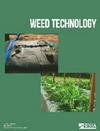美国苋菜(Amaranthus palmeri)和水麻(Amaranthus tuberculatus)对草铵膦、麦草畏和2,4- d敏感性的多态筛选
IF 1.7
3区 农林科学
Q3 AGRONOMY
引用次数: 0
摘要
摘要苋菜和水麻的除草剂抗性呈上升趋势,引起了美国种植者的极大关注。在美国对这两种杂草进行了多州筛选,以评估它们对草铵膦、麦草畏和2,4- d的敏感性。筛选的目的是通过在各自的标记率和一半标记率下测试每种除草剂,了解杂草的敏感性景观和抗性进化的新趋势。2019年,共从21个州收集了303种杂草种子,代表162种帕尔默苋菜和141种水麻种子,并在温室条件下进行了筛选。对不同种类和除草剂处理下不同样本量的统计能力和每次入库的存活概率进行了估计。总的来说,草甘膦、麦草畏和2,4- d对所有这些植物的效果都很好,平均伤害大于90%。除草剂伤害的变异性,如果有的话,在一些帕尔默苋菜品种中,2,4- d的标记率为一半,而水麻品种则表现出可变的敏感性,麦草畏和草铵膦的标记率为一半。该研究强调了在更广阔的土地上监测杂草除草剂敏感性的价值,以及草铵膦、麦草畏和2,4- d除草剂作为与其他化学、机械和文化实践相结合的多样化杂草控制计划的一部分,在管理麻烦杂草方面的重要性。本文章由计算机程序翻译,如有差异,请以英文原文为准。
Multi-State Screening of Palmer Amaranth (Amaranthus palmeri) and Waterhemp (Amaranthus tuberculatus) Sensitivity to Glufosinate, Dicamba and 2,4-D in the United States
Abstract Herbicide resistance in Palmer amaranth and waterhemp is on the rise and poses a great concern to growers in the United States. A multistate screening was conducted for these two weed species in the United States to assess their sensitivity to glufosinate, dicamba, and 2,4-D. The screening was designed to understand the weed sensitivity landscape and emerging trends in resistance evolution by testing each herbicide at its respective label rate and at half the label rate. A total of 303 weed seed accessions from 21 states representing 162 Palmer amaranth and 141 waterhemp seeds were collected from grower fields in 2019 and screened in greenhouse conditions. Statistical power of different sample sizes and probability of survivors in each accession were estimated for each species and herbicide treatment. Overall, the efficacy of glufosinate, dicamba, and 2,4-D against all these accessions was excellent, with greater than 90% average injury. The variability in herbicide injury, if any, was greater with half the label rate of 2,4-D in some Palmer amaranth accessions, while waterhemp accessions had exhibited variable sensitivity with half the label rate of dicamba and glufosinate. The study highlights the value of monitoring weeds for herbicide sensitivity across broader landscape and the importance of glufosinate, dicamba, and 2,4-D herbicides in managing troublesome weeds as part of a diversified weed control program integrated with other chemical, mechanical and cultural practices.
求助全文
通过发布文献求助,成功后即可免费获取论文全文。
去求助
来源期刊

Weed Technology
农林科学-农艺学
CiteScore
2.90
自引率
21.40%
发文量
89
审稿时长
12-24 weeks
期刊介绍:
Weed Technology publishes original research and scholarship in the form of peer-reviewed articles focused on understanding how weeds are managed.
The journal focuses on:
- Applied aspects concerning the management of weeds in agricultural systems
- Herbicides used to manage undesired vegetation, weed biology and control
- Weed/crop management systems
- Reports of new weed problems
-New technologies for weed management and special articles emphasizing technology transfer to improve weed control
-Articles dealing with plant growth regulators and management of undesired plant growth may also be accepted, provided there is clear relevance to weed science technology, e.g., turfgrass or woody plant management along rights-of-way, vegetation management in forest, aquatic, or other non-crop situations.
-Surveys, education, and extension topics related to weeds will also be considered
 求助内容:
求助内容: 应助结果提醒方式:
应助结果提醒方式:


